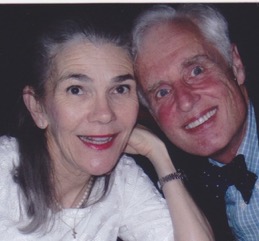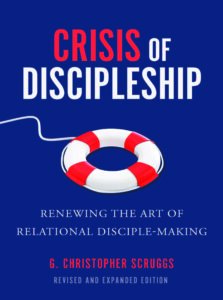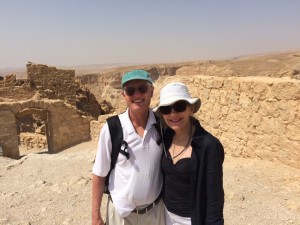The End of the Intellectual Search for Wisdom
 Wisdom literature is committed to an unflinching search for truth and an understanding of the reality of human life, squarely facing the problems inherent in a simple equation of blessings, success, and meaning with the wise life. [1] Job, Ecclesiastes, and Daniel, each in their own way, address the reality that good people suffer, much suffering does not make sense, and wisdom does not prevent a wise person from experiencing injustice and meaninglessness inherent to much of human life.
Wisdom literature is committed to an unflinching search for truth and an understanding of the reality of human life, squarely facing the problems inherent in a simple equation of blessings, success, and meaning with the wise life. [1] Job, Ecclesiastes, and Daniel, each in their own way, address the reality that good people suffer, much suffering does not make sense, and wisdom does not prevent a wise person from experiencing injustice and meaninglessness inherent to much of human life.
In Job and Ecclesiastes, one senses the conviction that any explanation of the human condition must finally come through a personal revelation. This is why Job is so insistent that he achieve a personal interview with God. His friends are not adequate mediators of reasons for his suffering. He wants his case, and by extrapolation, the case of every sufferer, to be personally heard by God and answered by God. You see, the character of God is at stake in the problems of meaningless and undeserved suffering. To a person who suffers undeservedly or loses a sense that life has meaning, God often seems strangely silent.
Near the end of Proverbs, a passage speaks of the ultimate helplessness of human reason in the face of the most profound questions of life. It is as if, in frustration, the wisdom writers finally confess the futility of trying to understand the ways of God:
I am weary, O God; I am weary and worn out, O God. I am too stupid to be human, and I lack common sense. I have not mastered human wisdom, nor do I know the Holy One. Who but God goes up to heaven and comes back down? Who holds the wind in his fists? Who wraps up the oceans in his cloak? Who has created the whole wide world? What is his name—and his son’s name? Tell me if you know! (Proverbs 30:1-4, NLT).
This passage expresses a fundamental problem with the human search for wisdom: We are not God. We cannot ascend to heaven and check our earthly conclusions with the Almighty. The search for God and for human wisdom concerning the most critical questions of life ultimately reaches the end of human understanding. More arguments will not suffice—a revelation is needed. One is tempted to quote the modern philosopher Ludwig Wittgenstein, “Whereof one cannot speak, thereof one must be silent.” [2]
Humans must live within the limits of human understanding. The ways of God are beyond our understanding. If humans are to find answers to life’s most troubling questions, God must reveal them. We cannot ascend to God or investigate God and find our answers. Since our deepest need for a sense of the presence of God, and not simply a word from God, the revelation we need must be personal, not merely verbal. [3]
One Greater than Solomon
New Testament writers would agree for a surprising reason: They had seen the mysterious, inscrutable God revealed in human flesh. When they saw Jesus, they saw revealed a kind of wisdom so different from their expectations that it initially seemed foolish. As they reflected on the revelation of Christ, they came to understand it as foundational to any rational understanding of God and the universe.
In Matthew 12, Jesus alludes to his special status. The Scribes and the Pharisees have been challenging Jesus because he seems not to follow the wisdom of the Jewish tradition as they understand it. Finally, Jesus responds. Here is how Matthew relates the story:
Then some of the scribes and Pharisees said, “Master, we want to see a sign from you.” But Jesus told them, “It is an evil and unfaithful generation that craves for a sign, and no sign will be given to it—except the sign of the prophet Jonah. For just as Jonah was in the belly of that great sea-monster for three days and nights, so will the Son of Man be in the heart of the earth for three days and nights. The men of Nineveh will stand up with this generation in the judgment and will condemn it. For they did repent when Jonah preached to them, and you have more than Jonah’s preaching with you now! The Queen of the South will stand up in the judgment with this generation and will condemn it. For she came from the ends of the earth to listen to the wisdom of Solomon, and you have more than the wisdom of Solomon with you now! (Matthew 12:33-42, J.B. Philips [emphasis added]).
The Scribes and the Pharisees wanted a sign that Jesus was an authentic teacher of the wisdom of God, which they could fit into their pre-existing worldview. They wanted a Messiah that fit their expectations. Jesus refused their request, telling them they would indeed get a sign—but not one that they could accept. Although in Jesus, one greater than Solomon is present, they will have to change their expectations in the face of the reality of the Messiah God has sent to them. [4]
Greater than Solomon? Who among the teachers of Israel could be greater than the patron saint of the wisdom tradition, the Son of David? Here, Jesus is making his case that, as “one has come down from heaven,” he is the authentic and reliable guide to the wise life. However, this is not a wisdom the world will easily recognize or accept. In fact, the very people who might have been expected to acknowledge Jesus as the bearer of true wisdom reject and crucify him.
The Word Made Flesh
It is not just the spoken words of Jesus that are important. In his very being, the Word and Wisdom of God are revealed. John begins his gospel:
In the beginning was the Word, and the Word was with God, and the Word was God. He was with God in the beginning. Through him all things were made; without him nothing was made that has been made. In him was life, and that life was the light of all mankind. The light shines in the darkness, and the darkness has not overcome it. … The Word became flesh and made his dwelling among us. We have seen his glory, the glory of the one and only Son, who came from the Father, full of grace and truth (John 1:1-8, 14, NIV).
In Christ, God has chosen to make a personal appearance in human history. In Jesus, the wisdom that was with the Father in the beginning as a master craftsman of creation (Proverbs 8) came to dwell in history in human form and is now revealed not just in words but also in a human being whose character is “full of Grace and Truth” (John 1:14).
Despite the presence of the True Light of God’s wisdom in Jesus, the True Light was not easy to recognize (John 1:9). In fact, “…though the world was made through him, the world did not recognize him” (John 1:10, NIV). When John says that the world did not receive him, he does not just mean the gentile nations who might be expected to miss the purpose and meaning of his life. Not even his own people, who had been prepared for his coming throughout their long history, understood. “He came to that which was his own, but his own did not receive him” (John 1:11, NIV).
The New Testament is replete with indications that even those closest to Jesus, the disciples, were often puzzled by Jesus and his teachings. [5] They did not always understand his parables and frequently had to have them explained to them (See Mark 4:13). In Matthew 13, Jesus tells a series of parables that his followers have difficulty understanding. Then, the reason is given:
Jesus spoke all these things to the crowd in parables; he did not say anything to them without using a parable. So was fulfilled what was spoken through the prophet: “I will open my mouth in parables, I will utter things hidden since the creation of the world” (Matthew 13:34-35, NIV).
Jesus’ teachings were difficult to understand, and his wisdom was often confusing because he revealed a hidden wisdom from God (I Corinthians 1:18-19). This wisdom can only be recognized based on the revelation God is making through Jesus.
The core misunderstanding of the disciples concerned the character of Jesus and God. Jesus revealed a wisdom that does not necessarily breed success or victory. It is not a wisdom that brings with it adulation of the crowds or political or economic power. It is not a wisdom that the best and the brightest of the academy will necessarily applaud. It is a wisdom that leads to a cross. It is wisdom shown by submitting to injustice. It is a wisdom symbolized by a cross. In other words, human wisdom formed by the notion that wisdom brings success and adulation is no kind of wisdom at all.
The Wisdom of the Cross
The apostle Paul expresses the surprise the apostles felt at Christ’s incomprehensible self-disclosure of God’s self-giving wisdom:
For the message of the cross is foolishness to those who are perishing, but to us who are being saved it is the power of God. For it is written: “I will destroy the wisdom of the wise; the intelligence of the intelligent I will frustrate.” Where is the wise person? Where is the teacher of the law? Where is the philosopher of this age? Has not God made foolish the wisdom of the world? For since in the wisdom of God the world through its wisdom did not know him, God was pleased through the foolishness of what was preached to save those who believe. Jews demand signs and Greeks look for wisdom, but we preach Christ crucified: a stumbling block to Jews and foolishness to Gentiles, but to those whom God has called, both Jews and Greeks, Christ the power of God and the wisdom of God. For the foolishness of God is wiser than human wisdom, and the weakness of God is stronger than human strength (I Corinthians 1:18-25, NIV).
The wisdom Christ revealed is so unimaginable that no form of human understanding could have foreseen its character. The Jews rejected it because it defied their messianic expectations of a military and political deliverer. The Greeks rejected it because their ideas of divinity postulated an impassible God who could not suffer, a God beyond the misery of this world and its bondage to sin, suffering, and death.
Thus, the wisdom of God is paradoxical—a wisdom that must be accepted by faith before it makes sense. It is a wisdom that no person wise by Jewish or Greek standards would have predicted. It is a wisdom revealed not in strength but in weakness and suffering love. It is a wisdom that does not fit into the categories of thought prevalent in Jesus’ day or our own. It cannot be assimilated into any human wisdom other than by making it the foundation of a new kind of wisdom. [6]
The reality and power of God’s wisdom can only be known in the person of the crucified and resurrected Jesus Messiah (I Corinthians 2:2). It can only be understood in humble reliance upon God’s mercy, which is its basis and foundation (I Corinthians 2:3). It cannot be known with the wisest and most persuasive arguments (I Corinthians 2:4-5). It can only be understood in the experience of personal forgiveness and restoration by the power of the Holy Spirit (I Corinthians 2:4-5).
This is a wisdom that cannot be known by the rulers and authorities of “this age” because it is a hidden wisdom:
But we speak God’s wisdom, secret and hidden, which God decreed before the ages for our glory. None of the rulers of this age understood this; for if they had, they would not have crucified the Lord of glory. But, as it is written, “What no eye has seen, nor ear heard, nor the human heart conceived, what God has prepared for those who love him”—these things God has revealed to us through the Spirit; for the Spirit searches everything, even the depths of God (I Corinthians 2:7-9, NRSV).
The ultimate expression of wisdom cannot be expressed in words. It had to be expressed on a cross and can only be appropriated in a personal relationship with God as revealed on the Cross. Those who understand this wisdom must have their minds transformed so they have the mind of Christ, the mind of the One who revealed this wisdom, this hidden word of God (I Corinthians 2:13-16).
This wisdom of the Cross reflects the true nature of the One who created the heavens and the earth. The world cannot understand this wisdom because its truth finally must be revealed to us by God. C. S. Lewis captures this mystery in his book, The Lion, the Witch and the Wardrobe. In the book, Edmund betrays his brother and sisters, the people of Narnia, and even Aslan, the true king of Narnia. He deserves to die—and the White Witch demands that he do so. Aslan strikes a bargain with the White Witch to substitute himself for Edmund. The Witch accepts, and Aslan is sacrificed only to be resurrected. When Lucy and Susan cannot understand what has happened, Aslan replies:
It means, said Aslan, “that though the Witch knew the Deep Magic, there is magic deeper still which she did not know. Her knowledge goes back only to the dawn of Time. But, if she could have looked a little further back, into the stillness and darkness before Time dawned, she would have read there a different incantation. She would have known that when a willing victim who had committed no treachery was killed in the traitor’s stead, the Table would crack and Death itself would start working backward.” [7]
The wisdom of the Cross is the Deeper Magic, the most profound wisdom that underlies and supports all human attempts to live and order their lives. On the Cross the limitations of a human notion of justice is demonstrated and a deeper wisdom, what we might call a “Wisdom of Grace,” is revealed. This wisdom is present in life and death, in success and failure, in deserved blessing and undeserved suffering, and in times of radiant meaning and purpose in the dark times when meaning and purpose seem absent.
The Way of Wisdom and New Testament Faith
 Contemporary people sometimes consider “faith and knowledge” and “theory and practice” as categories. We often think of “faith” as a kind of incomplete knowledge, or worse, something people choose to believe in the face of contrary facts. [8] Critics of Christianity often describe faith as irrational – a flight from reason. For these people, “faith” means holding to a belief despite the absence of evidence, or worse, against clear evidence. Even Christians can fall into thinking that faith is something alien to reason or, in some ways, opposed to reason. Much harmful debate between science and religion stems from this way of thinking.
Contemporary people sometimes consider “faith and knowledge” and “theory and practice” as categories. We often think of “faith” as a kind of incomplete knowledge, or worse, something people choose to believe in the face of contrary facts. [8] Critics of Christianity often describe faith as irrational – a flight from reason. For these people, “faith” means holding to a belief despite the absence of evidence, or worse, against clear evidence. Even Christians can fall into thinking that faith is something alien to reason or, in some ways, opposed to reason. Much harmful debate between science and religion stems from this way of thinking.
The false dichotomy between faith and reason is foreign to the spirit of the Christian Bible and the early Church’s writers. For early Christians, the revelation of Christ was a moment of deepened understanding of God and the universe God created. The early Church saw the incarnation as a physical revelation – a personal revealing inside of creation of the invisible wisdom of God (Colossians 1:15-17). This same divine wisdom was also revealed in nature (Romans 1:20). For these writers, practical wisdom, understanding reality, and moral knowledge come from the same source – the uncreated wisdom of God.
For those who accept this ancient way of wisdom, scientific understanding, faith, and moral insight are parts of a seamless web of created rationality binding the physical, ethical, and intellectual universe together. Eugene Peterson captures this notion in his paraphrase when he says, “…God’s law is not something alien, imposed on us from without, but woven into the very fabric of our creation. There is something deep within … that echoes God’s yes and no, right and wrong” (Romans 2:14, Message).
For early Christians, the revelation embodied in Jesus was not a flight into the irrational or a subjective world of metaphor. Instead, Christ provided a revelatory insight into the deepest rationality of the world. This is why an early Christian could say:
He is the image of the invisible God, the firstborn of all creation; for in him all things in heaven and on earth were created, things visible and invisible, whether thrones or dominions or rulers or powers—all things have been created through him and for him. He himself is before all things, and in him all things hold together (Colossians 1:15-17, NRSV).
For the writer of Colossians and early Christians generally, the revelation of Christ was a revelation of the ultimate rationality of the universe, the principle of reconciliation between the physical and moral universes. On the cross, God revealed the ultimate nature of the deity. He revealed God as Self-Giving Love—a love present in the meaningless parts of life and in the undeserved suffering we sometimes endure. In the resurrection of Jesus, God was revealing at the very boundaries of human reason the ultimate ground for our hope.
A Life Reordered by Transformational Insight
James Loder speaks of the importance of transformational knowing—a kind of knowing that re-orders all that we have previously known into a new order—an order that explains what was once inexplicable and makes rational what was once irrational. [9] Transformational knowledge results from a convictional insight that transforms understanding and reorders the human psyche. [10] The revelation of Christ is such a transformational insight. By faith, new understanding is created. This new understanding is not irrational. It is more profound than human rationality. It is not a form of foolishness. It is a wisdom that renders lesser insights foolish. This is the wisdom to which the New Testament writers bore witness.
The Old Testament wisdom writers were searching for truth—for a true way to find happiness and fulfillment. They did so in the context of their faith and God’s revelation to Israel. Their quest was confronted with difficulties that they wrestled with and sought to resolve. They sensed a deep conflict between the fundamental premises of the wisdom tradition and reality as they knew and experienced it.
They saw much-undeserved suffering in the world and understood a wise life does not guarantee happiness, fulfillment, or meaning. Over long centuries, wisdom writers struggled with these problems as they relate to their understanding of God, wisdom, morals, and the rationality of the world. Then, in the life, death, and resurrection of Jesus of Nazareth, the disciples experienced a complete reorienting of their ideas about God, the Law, and the Prophets.
The revelation they received made sense of what had previously been difficult, if not impossible, to understand. But that revelation required a rethinking and reenacting of the entire history of Israel, so surprising and revolutionary was its impact. In the figure of Christ, they saw revealed a wisdom of one greater than Solomon (Matthew 12:42), a prophet greater than Moses (Hebrews 3:3). They saw revealed in Christ the character of one who fulfilled the Law and Prophets (Matthew 5:17). In the crucified and risen Messiah, they received the clue to the mystery their tradition had so long pondered. In the one life of Jesus of Nazareth, they saw the wisdom of God revealed in the most unexpected yet undeniable way. It was for them and us to work out the implications of that revelation. [11]
Because of the personal nature of the revelation of Christ, no purely mental, cognitive response can ever be sufficient. The proper response of faith is to not simply cognitively accept what God has done in Christ. The word for faith connotes more than acceptance. It also connotes trust, and trust requires an act of personal commitment and will. To trust in Christ and to receive his wisdom is to be converted in our minds (what we think), in our bodies (what we do), and in our hearts (what we feel and will do). A personal revelation demands a personal response from the whole human person. Wisdom is never a matter of abstract cognitive knowing. Wisdom is practical. It is a matter of knowing and doing in a concrete human life formed in a relationship with God, a concrete community, and the world.
Copyright 2024, G. Christopher Scruggs, All Rights Reserved
[1] This entire essay is a revision of chapter 14 of my book, Path of Life: The Way of Wisdom for Christ Followers (Eugene, OR: Wipf & Stock, 2014), 195ff.
[2] Ludwig Wittgenstein, Tractatus Logico-Philosophicus (London, ENG: Kegan Paul, Trench, Turner & Co, 1922), 90.
[3] This is one reason pastors and other caregivers quickly learn that our presence with people who are suffering is far more important than anything we may say. In fact, as Job’s friends illustrate, what we say may interfere with the comfort of our presence!
[4] Thomas F. Torrance, Theological Science (New York, NY: Oxford University Press, 1969). In scientific, religious, and other thinking there can only be real knowledge when an investigator adjusts his or her view of reality to the nature of the subject matter. “[In] Jesus Christ God has broken into the closed circle of our inability and adequacy, and estrangement and self-will, and within our alien condition has achieved and established real knowledge of Himself.” Id, at 51.
[5] One of the motifs of the Gospel of Mark is the incomprehension of the disciples despite their constant contact with Jesus.
[6] Lesslie Newbigin, Foolishness to the Greeks: The Gospel and Western Culture (Grand Rapids, MI: William B. Eerdmans, 1986).
[7] C. S. Lewis, The Lion, the Witch and the Wardrobe (New York, NY: HarperCollins Publishers, 1950, renewed 1978), 74.
[8] This section contains ideas first presented in Centered Living, Centered Leading: The Way of Light and Love for Christ-Followers previously cited.
[9] See, James E. Loder, The Transforming Moment 2nd ed. (Colorado Springs, CO: Helmers and Howard, 1989).
[10] Id, at 33.
[11] In this section, I use Loder’s notion of “convictional knowing” and its stages of: conflict, scanning, revelation (what he calls “imagination”), release, and interpretation to express the way in which the revelation of Christ impacted the disciples’ (and our) expectation of the Messiah. See, Loder, Transforming Moment, at 35-44.
 People are always intrigued by the prospect of Jesus’s Second Coming. Some groups anticipate that Jesus will return, not unexpectedly but in a way they have already imagined. He will come as the Just Conqueror, riding upon a white steed and triumphing over the enemies of God. This view is widely promoted in popular literature about the Second Coming. Years ago, a popular adult teacher in one of our congregations fervently advocated this view, dedicating many weeks to teaching Revelation and the Second Coming from this perspective. The topic arose in a class I was teaching at the time. I have always believed, and still do that we cannot predict how history will conclude or how Christ will defeat evil. However, his first coming might offer insights into attitudes we should avoid.
People are always intrigued by the prospect of Jesus’s Second Coming. Some groups anticipate that Jesus will return, not unexpectedly but in a way they have already imagined. He will come as the Just Conqueror, riding upon a white steed and triumphing over the enemies of God. This view is widely promoted in popular literature about the Second Coming. Years ago, a popular adult teacher in one of our congregations fervently advocated this view, dedicating many weeks to teaching Revelation and the Second Coming from this perspective. The topic arose in a class I was teaching at the time. I have always believed, and still do that we cannot predict how history will conclude or how Christ will defeat evil. However, his first coming might offer insights into attitudes we should avoid. The Philosopher Charles Peirce, whose work I have reviewed in the past in these blogs, did not like the Revelation of St. John. He thought it an angry and bloodthirsty book describing a God in complete disparity with the God of Love found in the Gospel and Letters. [1] There is a point to what Peirce, who was reasonably devout, says. Nevertheless, it seems to me that the point is based on the same misreading of Revelation that I find in other writers: A failure to take seriously the symbolic nature of the book and the likely true meaning of the symbols.
The Philosopher Charles Peirce, whose work I have reviewed in the past in these blogs, did not like the Revelation of St. John. He thought it an angry and bloodthirsty book describing a God in complete disparity with the God of Love found in the Gospel and Letters. [1] There is a point to what Peirce, who was reasonably devout, says. Nevertheless, it seems to me that the point is based on the same misreading of Revelation that I find in other writers: A failure to take seriously the symbolic nature of the book and the likely true meaning of the symbols.













